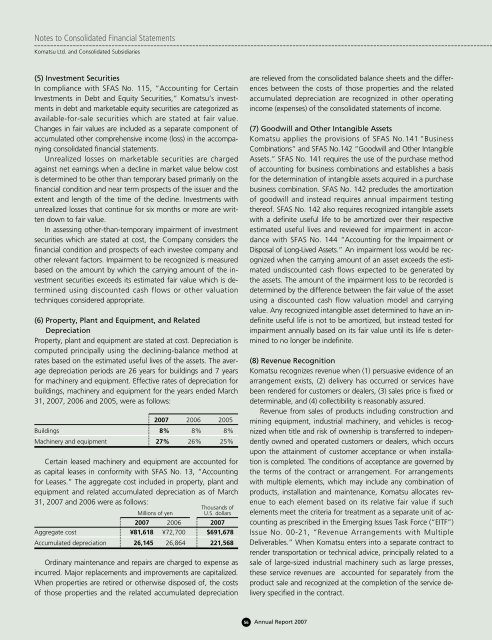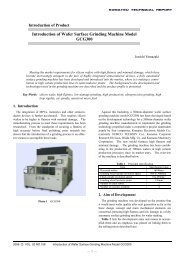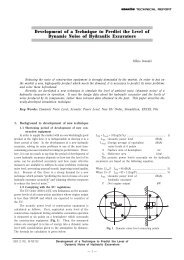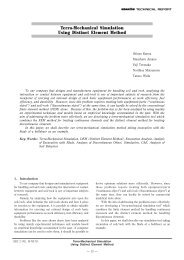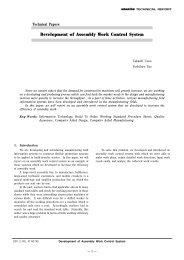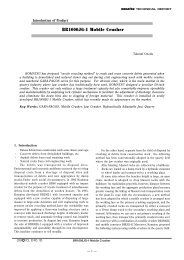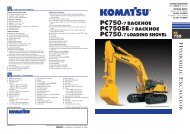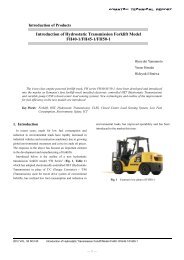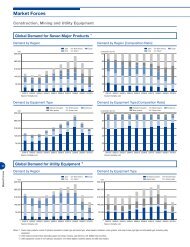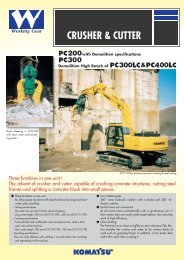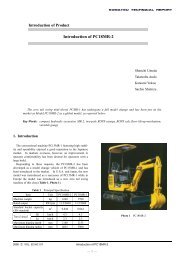Annual Report 2007 - Komatsu
Annual Report 2007 - Komatsu
Annual Report 2007 - Komatsu
Create successful ePaper yourself
Turn your PDF publications into a flip-book with our unique Google optimized e-Paper software.
Notes to Consolidated Financial Statements<br />
<strong>Komatsu</strong> Ltd. and Consolidated Subsidiaries<br />
(5) Investment Securities<br />
In compliance with SFAS No. 115, “Accounting for Certain<br />
Investments in Debt and Equity Securities,” <strong>Komatsu</strong>’s investments<br />
in debt and marketable equity securities are categorized as<br />
available-for-sale securities which are stated at fair value.<br />
Changes in fair values are included as a separate component of<br />
accumulated other comprehensive income (loss) in the accompanying<br />
consolidated financial statements.<br />
Unrealized losses on marketable securities are charged<br />
against net earnings when a decline in market value below cost<br />
is determined to be other than temporary based primarily on the<br />
financial condition and near term prospects of the issuer and the<br />
extent and length of the time of the decline. Investments with<br />
unrealized losses that continue for six months or more are written<br />
down to fair value.<br />
In assessing other-than-temporary impairment of investment<br />
securities which are stated at cost, the Company considers the<br />
financial condition and prospects of each investee company and<br />
other relevant factors. Impairment to be recognized is measured<br />
based on the amount by which the carrying amount of the investment<br />
securities exceeds its estimated fair value which is determined<br />
using discounted cash flows or other valuation<br />
techniques considered appropriate.<br />
(6) Property, Plant and Equipment, and Related<br />
Depreciation<br />
Property, plant and equipment are stated at cost. Depreciation is<br />
computed principally using the declining-balance method at<br />
rates based on the estimated useful lives of the assets. The average<br />
depreciation periods are 26 years for buildings and 7 years<br />
for machinery and equipment. Effective rates of depreciation for<br />
buildings, machinery and equipment for the years ended March<br />
31, <strong>2007</strong>, 2006 and 2005, were as follows:<br />
<strong>2007</strong> 2006 2005<br />
Buildings 8% 8% 8%<br />
Machinery and equipment 27% 26% 25%<br />
Certain leased machinery and equipment are accounted for<br />
as capital leases in conformity with SFAS No. 13, “Accounting<br />
for Leases.” The aggregate cost included in property, plant and<br />
equipment and related accumulated depreciation as of March<br />
31, <strong>2007</strong> and 2006 were as follows:<br />
Millions of yen<br />
Thousands of<br />
U.S. dollars<br />
<strong>2007</strong> 2006 <strong>2007</strong><br />
Aggregate cost ¥81,618 ¥72,700 $691,678<br />
Accumulated depreciation 26,145 26,864 221,568<br />
Ordinary maintenance and repairs are charged to expense as<br />
incurred. Major replacements and improvements are capitalized.<br />
When properties are retired or otherwise disposed of, the costs<br />
of those properties and the related accumulated depreciation<br />
are relieved from the consolidated balance sheets and the differences<br />
between the costs of those properties and the related<br />
accumulated depreciation are recognized in other operating<br />
income (expenses) of the consolidated statements of income.<br />
(7) Goodwill and Other Intangible Assets<br />
<strong>Komatsu</strong> applies the provisions of SFAS No.141 “Business<br />
Combinations” and SFAS No.142 “Goodwill and Other Intangible<br />
Assets.” SFAS No. 141 requires the use of the purchase method<br />
of accounting for business combinations and establishes a basis<br />
for the determination of intangible assets acquired in a purchase<br />
business combination. SFAS No. 142 precludes the amortization<br />
of goodwill and instead requires annual impairment testing<br />
thereof. SFAS No. 142 also requires recognized intangible assets<br />
with a definite useful life to be amortized over their respective<br />
estimated useful lives and reviewed for impairment in accordance<br />
with SFAS No. 144 “Accounting for the Impairment or<br />
Disposal of Long-Lived Assets.” An impairment loss would be recognized<br />
when the carrying amount of an asset exceeds the estimated<br />
undiscounted cash flows expected to be generated by<br />
the assets. The amount of the impairment loss to be recorded is<br />
determined by the difference between the fair value of the asset<br />
using a discounted cash flow valuation model and carrying<br />
value. Any recognized intangible asset determined to have an indefinite<br />
useful life is not to be amortized, but instead tested for<br />
impairment annually based on its fair value until its life is determined<br />
to no longer be indefinite.<br />
(8) Revenue Recognition<br />
<strong>Komatsu</strong> recognizes revenue when (1) persuasive evidence of an<br />
arrangement exists, (2) delivery has occurred or services have<br />
been rendered for customers or dealers, (3) sales price is fixed or<br />
determinable, and (4) collectibility is reasonably assured.<br />
Revenue from sales of products including construction and<br />
mining equipment, industrial machinery, and vehicles is recognized<br />
when title and risk of ownership is transferred to independently<br />
owned and operated customers or dealers, which occurs<br />
upon the attainment of customer acceptance or when installation<br />
is completed. The conditions of acceptance are governed by<br />
the terms of the contract or arrangement. For arrangements<br />
with multiple elements, which may include any combination of<br />
products, installation and maintenance, <strong>Komatsu</strong> allocates revenue<br />
to each element based on its relative fair value if such<br />
elements meet the criteria for treatment as a separate unit of accounting<br />
as prescribed in the Emerging Issues Task Force (“EITF”)<br />
Issue No. 00-21, “Revenue Arrangements with Multiple<br />
Deliverables.” When <strong>Komatsu</strong> enters into a separate contract to<br />
render transportation or technical advice, principally related to a<br />
sale of large-sized industrial machinery such as large presses,<br />
these service revenues are accounted for separately from the<br />
product sale and recognized at the completion of the service delivery<br />
specified in the contract.<br />
56 <strong>Annual</strong> <strong>Report</strong> <strong>2007</strong>


